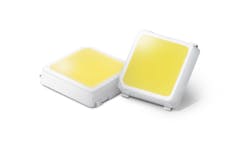Packaged LED news: Samsung amps color, Lumileds amps performance
Samsung has announced the LM301B EVO family of 3030 (3×3-mm) LEDs with enhanced packaging and phosphor technology that improve light quality and specifically enhance red spectral energy for warm tones and excellent color rendering. Lumileds has announced improvements in the Luxeon 5050 Series that allow the LEDs to better serve in extreme high-output applications such as street lighting, and the company is further characterizing the components for horticultural lighting.
The new Samsung LEDs actually push both performance and light quality — improvements that would allow the mid-power LEDs to usurp high-power components in general illumination indoor applications and also industrial applications. The components use Samsung’s flip-chip technology that has been evolved over many LED developments in the LM301 family. All the way back in 2017 we wrote that Samsung had pushed efficacy in the family to 220 lm/W in the LM301B.
Now the LM301B EVO maxes out at 235 lm/W. The improved performance is due primarily to new reflective material that encapsulates the chip and also improved phosphor-conversion efficiency. At the same time, a new phosphor formulation delivers that improved color quality.
“Our new LM301B EVO offers an unrivaled mix of light efficacy and color rendering that aligns nicely with the changing landscape of LED lighting standards,” said Un Soo Kim, senior vice president of the LED Business Team at Samsung Electronics. “Samsung will continue to provide value-added LED light sources through technological innovation, as we push hard to exceed energy standards across the globe.”
The improvements in light quality means that solid-state lighting (SSL) products based on the new LEDs can meet the DLC (DesignLights Consortium) V5.1 Premium photometric performance requirements. Moreover, Europe has also seen more stringent quality policy come from the Energy Related Product Directive (ErP), and the new LM301B EVO LEDs will also support developments that meet ErP Directive Grade A certification.
Samsung is offering the LEDs across the range of 2700K to 6500K CCT. The company will also offer the LEDs integrated on Level 2 modules for quick time to market. Q-Series EVO modules target indoor and educational applications. H inFlux EVO modules target high-ceiling applications including factories and warehouses.
Lumileds 5050 LEDs
Lumileds, meanwhile, continues to advance the 5050 technology that it considers a high-power device although it uses mid-power-like packaging technology. The company had just announced performance increases in the Luxeon 5050 family last August, saying flux output had increased 2–3%. The family had originally come to market back in 2018. Lumileds now says that 70-CRI LEDs have gained an additional 5 lm. To put that into perspective, consider that a 15,000-lm street light based on the products would now require 10% fewer LEDs, resulting in significant cost savings.
“High efficacy, high light output, and corrosion resistance that outperforms others are key to the preference for Luxeon 5050,” said Mei Yi, Lumileds product marketing manager. “We’ve continued to invest in this LED platform, and as a result, our customers can continue to optimize their solutions and support sustainability while improving lighting.”
Lumileds has targeted a variety of high-output applications with the 5050 LEDs, including the aforementioned street lights and also high-bay lighting. Moreover, Lumileds customers in the horticultural lighting sector have found the devices attractive as light recipes have trended toward broader spectral power distributions (SPDs) and as Lumileds has made the plastic-packages more capable of operating in harsh environments.
Lumileds also said it will now include photometric characterization of the LEDs using horticultural metrics in addition to general illumination metrics. The company had done that previously with the Luxeon 3030 HE Plus, publishing PPF (photosynthetic photon flux) specification in μmol/s and PPE (photosynthetic photon efficacy) in μmol/J. Those specs are not yet posted on the Lumileds 5050 web page, but we’d expect to see them soon.
LEDs Magazine chief editor MAURY WRIGHT is an electronics engineer turned technology journalist, who has focused specifically on the LED & Lighting industry for the past decade.
For up-to-the-minute LED and SSL updates, why not follow us on Twitter? You’ll find curated content and commentary, as well as information on industry events, webcasts, and surveys on our LinkedIn Company Page and our Facebook page.

Maury Wright | Editor in Chief
Maury Wright is an electronics engineer turned technology journalist, who has focused specifically on the LED & Lighting industry for the past decade. Wright first wrote for LEDs Magazine as a contractor in 2010, and took over as Editor-in-Chief in 2012. He has broad experience in technology areas ranging from microprocessors to digital media to wireless networks that he gained over 30 years in the trade press. Wright has experience running global editorial operations, such as during his tenure as worldwide editorial director of EDN Magazine, and has been instrumental in launching publication websites going back to the earliest days of the Internet. Wright has won numerous industry awards, including multiple ASBPE national awards for B2B journalism excellence, and has received finalist recognition for LEDs Magazine in the FOLIO Eddie Awards. He received a BS in electrical engineering from Auburn University.






